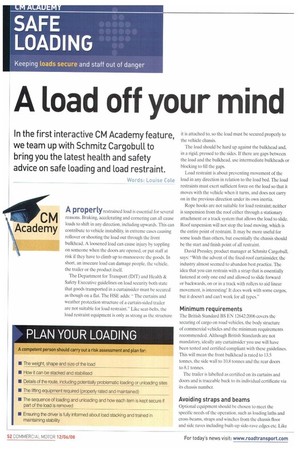A load off your mind
Page 52

Page 53

If you've noticed an error in this article please click here to report it so we can fix it.
In the first interactive CM Academy feature, we team up with Schmitz Cargobull to bring you the latest health and safety advice on safe loading and load restraint.
Words: Louise Cole
A properly restrained load is essential for several reasons. Braking, accelerating and cornering can all cause loads to shift in any direction, including upwards. This can contribute to vehicle instability, in extreme cases causing rollover or shooting the load out through the front bulkhead. A loosened load can cause injury by toppling on someone when the doors are opened, or put staff at risk if they have to climb up to manoeuvre the goods. In short, an insecure load can damage people, the vehicle, the trailer or the product itself.
The Department for Transport (DfT) and Health & Safety Executive guidelines on load security both state that goods transported in a curtainsider must be secured as though on a flat. The HSE adds: The curtains and weather protection structure of a curtain-sided trailer are not suitable for load restraint." Like seat-belts, the load restraint equipment is only as strong as the structure it is attached to, so the load must be secured properly to the vehicle chassis.
The load should be hard up against the bulkhead and, in a rigid, pressed to the sides. If there are gaps between the load and the bulkhead, use intermediate bulkheads or blocking to fill the gaps.
Load restraint is about preventing movement of the load in any direction in relation to the load bed. The load restraints must exert sufficient force on the load so that it moves with the vehicle when it turns, and does not carry on in the previous direction under its own inertia.
Rope hooks are not suitable for load restraint; neither is suspension from the roof either through a stationary attachment or a track system that allows the load to slide. Roof suspension will not stop the load moving, which is the entire point of restraint. It may be more useful for some loads than others, but essentially the chassis should be the start and finish point of all restraint.
David Pressley, product manager at Schmitz Cargobull, says: -With the advent of the fixed-roof curtainsider, the industry almost seemed to abandon best practice. The idea that you can restrain with a strap that is essentially fastened at only one end and allowed to slide forward or backwards, on or in a track with rollers to aid linear movement, is interesting! It does work with some cargos, but it doesn't and can't work for all types."
Minimum requirements
The British Standard BS F-N 12642:2006 covers the securing of cargo on road vehicles, the body structure of commercial vehicles and the minimum requirements recommended. Although British Standards are not mandatory, ideally any curtainsider you use will have been tested and certified compliant with these guidelines. This will mean the front bulkhead is rated to 13.5 tonnes, the side wall to 10.8 tonnes and the rear doors to 8.1 tonnes.
The trailer is labelled as certified on its curtains and doors and is traceable back to its individual certificate via its chassis number.
Avoiding straps and beams Optional equipment should be chosen to meet the specific needs of the operation, such as loading laths and cross-beams, straps and winches from the chassis floor and side raves including built-up side-rave edges etc. Like
most modern trailers, all Schmitz curtainsiders come with at least 13 pairs of evenly spaced tie-down rings rated at 2.0 tonnes, which can be fastened from above or below with an overhanging load.
But Pressley says the key is in how you use them: "By strapping or tying down to the chassis we ensure that the load is secured to the moving vehicle. Normal tether and strap angles should be observed to protect against the braking force loads trying to propel a pallet or loaded item forward in the direction of travel.
"But the big issue facing the industry is loose items used to fix down loads. Companies provide the correct straps, beams and fastenings, but are plagued by losses or theft. This then leads to short cuts being taken by drivers and operators who are using their initiative to keep the job moving. Even the best-run operations can't always prevent this becoming a potential health and safety issue."
Pressley says it is relatively easy for operators to find safe alternatives for daily loads, but occasional loads of a different nature can be more challenging. Schmitz Cargobull recommends moveable modular systems within the trailer. These allow a certain amount of flexibility and include storage racks for equipment. "Flexibility and the capacity to store kit as well as cargo keeps the operator safe," says Pressley.
Proper training, regular equipment checks and documentation is also important for compliance. "Involving drivers is crucial," he says. "Giving ownership to the users is all part of best practice."
Play it safe
It's worth remembering that there is no point making your load safe if people are put at risk securing it or removing the restraints.
Different systems will work for different load types, but whatever system is used it must not introduce additional risk for instance, someone having to climb or balance on top of the load. If workers have to reach heights they should have safety ladders or raised platforms. •
More information:
1-15E guidance on load security www.hse.gov.uk/haulage/load.htm DfT code of practice: safety of loads on vehicles www.dft.gov.uk/pgdroads/vehiclesivssafety/ safetyofloadsonvehiclescodeo4566 EU hest practice guidelines
















































































































































































